Solenogyne gunnii
(Hook.f.) CabreraLeaves narrowly obovate, (1–)2–7(–10) cm long, 5–12(–20) mm wide, obtuse, sessile or with a short petiole-like base to one-fifth the length of the blade; margins crenate to dentate, with (5–)9–13(–15) teeth; surfaces evenly pilose to hirsute with erect septate hairs. Peduncles from c. one-third as long in flower to slightly longer than leaves in fruit. Capitula 3–7 mm diam.; involucral bracts obovate, very obtuse, 2–2.5 mm long, with a pale, narrow, erose membranous margin; female florets c. 15–30, c. 1 mm long, pale (rarely purplish); disc florets (4–)7–9, c. 2 mm long. Cypsela narrowly elliptic or obovate, sometimes with a very short subapical neck 2–2.5 mm long, pale brown. Flowers mostly Dec.–May.
Wim, GleP, VVP, VRiv, MuF, GipP, Gold, CVU, GGr, DunT, NIS, EGL, EGU, HSF, HNF, Strz, MonT, HFE, VAlp. Also Qld, NSW, Tas. Naturalized New Zealand. Scattered through the state in light forest, woodland, grassland and sometimes urban lawns, usually on rather poor soils, sometimes occurring with S. dominii, but commoner south of the Great Dividing Range.
Walsh, N.G. (1999). Solenogyne. In: Walsh, N.G.; Entwisle, T.J., Flora of Victoria Vol. 4, Cornaceae to Asteraceae, pp. 867–868. Inkata Press, Melbourne.
 Spinning
Spinning

